The African Mambele Sword and Its Fearsome Sickle Blade

What’s in this article?
Many African swords are a direct inspiration for modern media because of their unique and terrifying appearance. The sickle Mambele or Mambeli sword is one such weapon commonly seen in movies and believed to have been used as both a deadly piercing weapon and a curved throwing dagger.
Its design comes from an agriculture sickle or a hybrid knife originating in Central Africa used for throwing. This article will review the different types of Mambele swords and delve into their details and characteristics. Then we will explain how they were best used and review this weapon’s origins.
Types of Mambele Swords

Mambele swords are sickle-shaped tools or weapons with a broadened blade tip and a curved blade usually made of iron. It can feature many different types but does not have extensions of the blade seen in African throwing sickle daggers.
The types of Mambele are usually differentiated in their length and curvature of the blade. Sometimes they can be radically curved with a massive blade tip, while some resemble a Khopesh form but still have the broadened blade tip at the end. Some Mambele don’t feature the blade tip but have the same curve, guard, handle, and pommel design.
Characteristic of the Mambele Sword

The Mambele sword is a sickle-like weapon and a fairly large instrument compared to smaller African throwing daggers. It stands out due to its design and the widening at the end of the blade. This sword is not very big, and its characteristics make it a melee weapon, not a throwing one, as it’s commonly believed.
Blade

The strongest and most visual characteristic of the Mambele is its blade. The Mambele sword has a sickle-shaped blade on the outer side shaped like a crescent moon, the opposite of the Egyptian Khopesh, which is believed to be the inspiration for the sword. This blade was usually iron but could be stronger if made from steel. The typical length of the Mambele sword is 26 to 30 inches (66 to 76 cm).
The Mambele blade is single-edged, meaning sharpened on the inner side of the curve but double-edged on the ending extension. This extension and broadening make the blade larger and more effective for piercing. It is the deadliest part of the blade, intended to go through flesh or pull down enemy shields.
A large chunk of the blade near the guard is unsharpened, forming a ricasso that could be used for half-swording and pulling down shields with both hands if needed. The blade could be flat or feature a fuller, which makes it lighter and reinforces the spine.
Guard
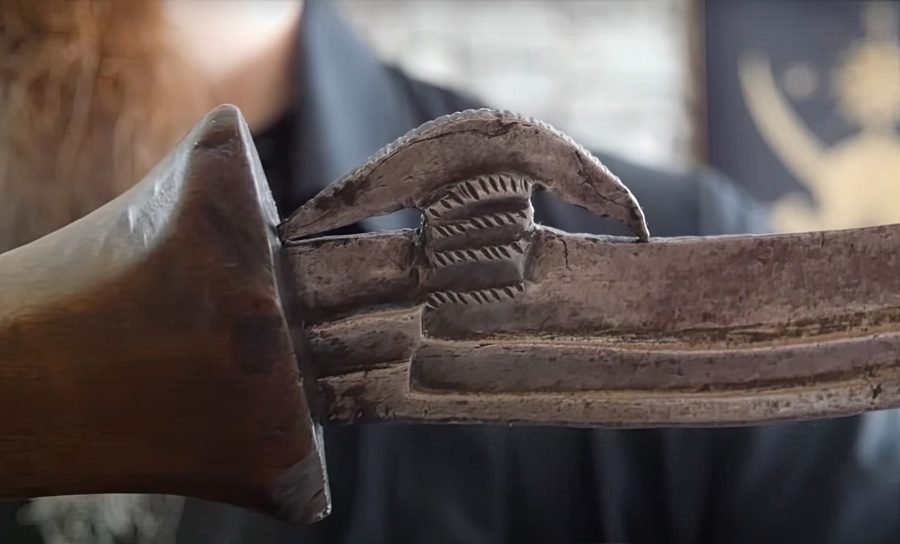
Mambele swords usually feature no guard, possibly because the sword originated and was formed from a throwing dagger. This sword offers no protection to the user’s hand, and like many other African swords, it was used in conjunction with a large shield for protection, allowing for more versatile moves.
However, the ear or metal piece sticking out from the neck of the blade may have resembled a guard. This part of the blade was about an inch (2.5 cm) and straight before the actual curve began. From here, a small metal piece in the shape of an ear extends and could be used for protection or as a way to tighten a rope or leather from the pommel to the guard.
Handle
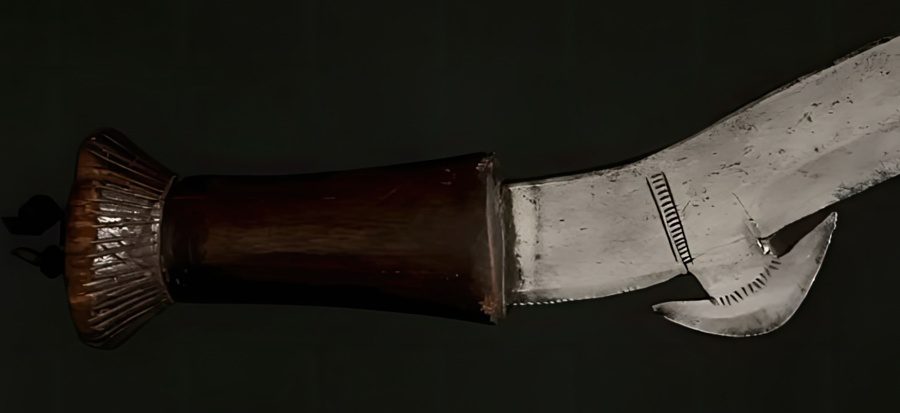
The handle of the Mambele sword is one-handed, meaning it is an exact fit for one hand. It is usually made in the traditional African handle shape, an hourglass design with a broader top and bottom. This allows for a firm grip when performing unorthodox and versatile attacks.
The handle is often bare and made of wood, but there are cases where it can be wrapped with animal skin, metal wire, plant fibers, or light aluminum. It is an open-style guard that offers no protection to the wielder’s hands. The standard handle length for the Mambele sword is 4 to 6 inches (10 to 15 cm).
Pommel
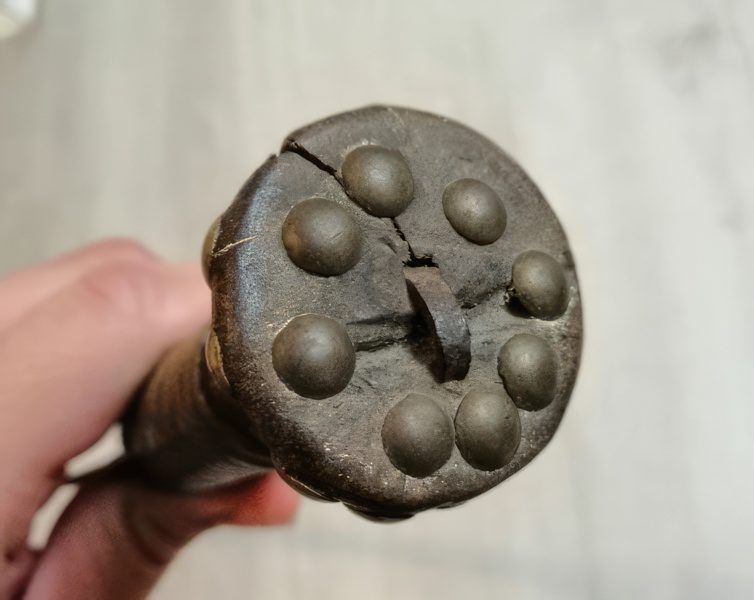
Some Mambele swords can feature a pommel, a piece of metal made to balance the blade, while others have larger bottoms to the handle that can act as pommels. These pommels are usually made of brass and can have decorations depending on the individual’s rank. Those of higher social standing would have been given a more elaborate sword. Sometimes, the full-tang blade was twisted and stuck out of the handle to mimic a pommel.
The common practice for the Mambele pommel is the addition of an opened cap hole for a rope or cord to go through and connect with the blade ear guard. This can make the Mambele easier to carry and offer a better grip for the user.
Size and Length
Despite its design, the Mambele is a small sword commonly in the range of 25 to 37 inches (65 to 95 cm). This is the ideal dimension for a sword to be used with one hand, along with a strong curve that won’t break after several strikes on the intended target.
Weight
Being a sword capable of various types of attacks, including being thrown like a boomerang, requires it to be lightweight. The weight of the Mambele sword averages 1.65 lbs (0.75 kg), making it an easy sword to carry on the waist or shoulders.
Uses of the Mambele Sword
The Mambele sickle sword is primarily a melee weapon because of its design, length, and shape. It is used with one hand and often combined with a large shield. The most important factor when using this sword is footwork, swiftly hopping around the target while reflecting unexpected strikes.
Warfare & Hunting
Mambele swords were used as a warfare tool, more as a piercing weapon rather than a slashing one. The sickle sword on the Mambele was fairly common in African regions because while it wasn’t overly effective against armor, it excelled when battling large shields used during the time. This design of the Mambele is to hit the target behind the shield, delivering deep puncture wounds and internal damage.
Some cases of African warfare leave the battlefield open, making it easy for the enemy to escape. In this case, the Mambele would have been used by tribes as an act of intimidation.
Another use for the Mambele was hunting, along with a smaller sickle-shaped throwing knife. If a hunted animal were to encounter the Mambele sickle sword, the blade tip would easily tear through its body, leading to a painful death.
Dueling
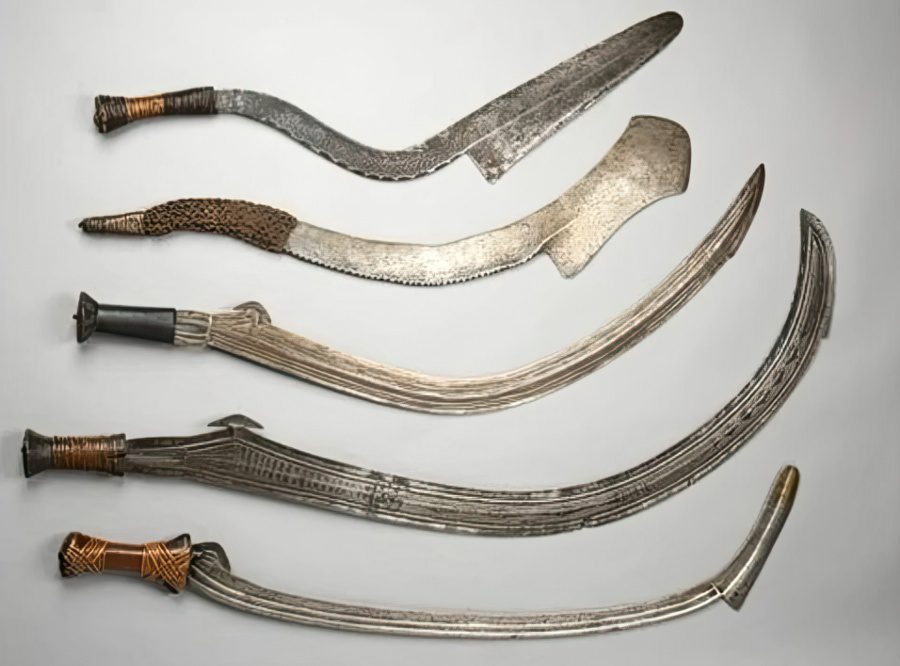
The Mambele could be used as a dueling or fencing sword commonly seen today in African traditional martial art dances. Although there is little historical evidence, these shapes of swords that compromised their fighting capability could be used in formalized combat with a code where death is not the end goal. This theory might be disputed, but in many African cultures throughout the continent, there were numerous duels with swords.
Prestigious & Weapon of Rank
The Mambele sword is tightly rooted in Central African culture and is a highly valued piece of metal in many regions. Europeans who traveled to the region claimed the sword was ceremonial and tied with prestige and rank rather than for warfare. It was also used in cultural celebrations, weddings, and religious gatherings.
Many foreign countries were on the hunt for these swords because of their high status, and they can be seen today in museums in Belgium and England.
Trade Currency
In some African countries today, the Mambele is seen as a form of currency rather than a weapon of war. Metal and iron were once very rare in Africa and used as valuable currency, and this belief is still practiced today. Highly decorated African iron swords like the Mambele sword were among the most popular with traders and merchants.
History and Origins of the Mambele Sword

The Mambele is an African sword used mainly in the Central African regions of modern-day Sudan, northern parts of the Democratic Republic of Congo, the Central African Republic, and Gabon. It was a popular sword used primarily by the Bandia, Mongelima, Zande, Zaire, Boa, and Mangbetu people.
The theory and origins are disputed, as with many other African iron weapons. Like the Ethiopian Shotel, some folks trace the form of the Mambele to be directly inspired by the Egyptian Khopesh and possibly date back into antiquity.
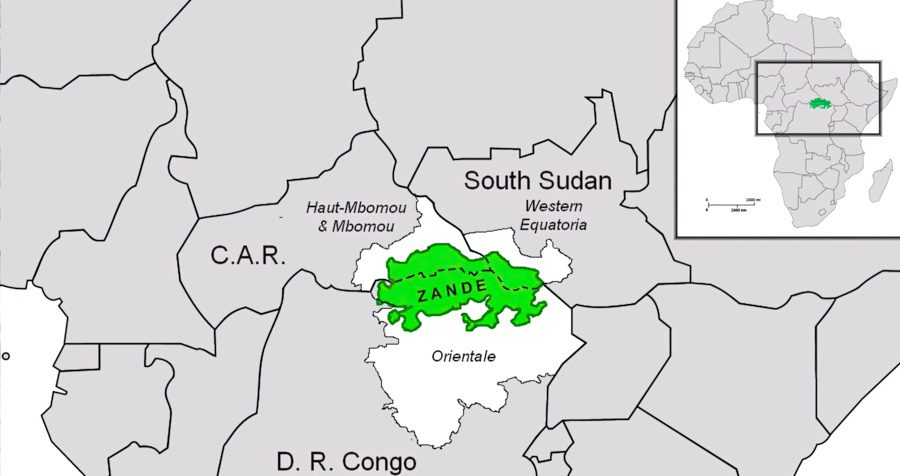
The prototype of Mambele was a throwable dagger which may have been called Hunga Munga, which existed in Northern and Southern Africa. It was of very high value in hunting, warfare, and nobility and influenced the larger sickle Mambele as we know it today in Central Africa. However, the Mambele sickle sword is not the same weapon as the Hunga Munga and is not to be confused with other names such as Kpinga, Danisco, and Njiga.
The main difference between the Mambele sickle sword and the Hunga Munga is how they are used. The Mambele is slashed like a hatchet, while the Hunga Munga is thrown horizontally from a distance.





